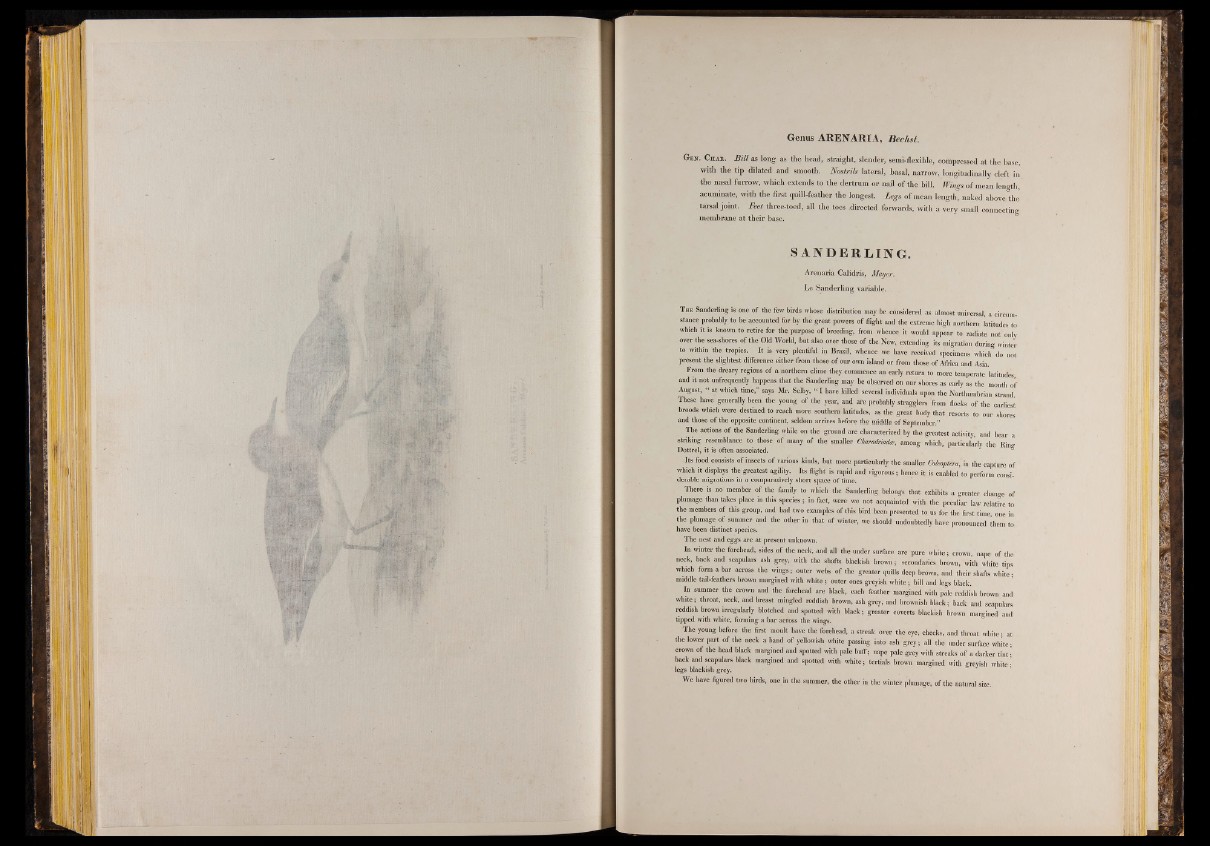
Genus ARENARIA, Bechst.
G e k . C h a e . B i l l as lo n g as th e he ad, straigh t, slender, semi-flexible, compressed at the base,
w ith th e t ip dila ted and smooth. N o s tr ils lateral, basal, n arrow, lon g itu d in a lly cleft in
th e nasal fu r row , w h ich extends to th e de rtrum o r n a il o f the bill. W ings o f mean length ,
acuminate, w ith th e first quill-feather th e longest. L e g s o f m ean len g th , naked ab ove the”
tarsal jo in t . F e e t three-toed, a ll the toes directed forwards, w ith a v e r y small connecting
membrane at th eir base.
S ANDERLING.
A ren a r ia Calidris, M eyer.
L e San d e r lin g variable. .
T he Sanderling is one o f the few birds whose distribution may be considered as almost universal, a circumstance
probably to be accounted for by the great powers o f flight and the extreme high northern latitudes to
which it is known to retire for the purpose o f breeding, from whence it would appear to radiate not 'only
over the sea-shores o f the Old World, but also over those o f the New, extending its migration during winter
to within the tropics. It is very plentiful in Brazil, whence we have received specimens which do not
present the slightest difference either from those o f our own island or from those o f Africa and Asia.
From the dreary regions o f a northern clime they commence an early return to more temperate latitudes
and it not unfrequently happens that the Sanderling may be observed on our shores as early as the month o f
August, “ at which time,” says Mr. Selby, “ I have killed several individuals upon, the Northumbrian strand
These have generally been the young o f the year, and are probably stragglers from flocks o f the earliest
broods which were destined to reach more southern latitudes, as the great body that resorts to our shores
and those of the opposite continent, seldom arrives before the middle o f September.”
The actions o f the Sanderling while on the ground are characterized by the greatest activity, and hear a
striking resemblance to those o f many o f the smaller Charadriaiee, among which, particularly the Bing
Dottrel, it is often associated.
Its food consists o f insects o f various kinds, but more particularly the smaller Coleóptera, in the capture of
which it displays the greatest agility. Its flight is rapid and vigorous ¡ hence it is enabled to perform consi-
derable migrations in a comparatively short space o f time.
There is no member o f the family to which the Sanderling belongs that exhibits a greater change of
plumage than takes place in this species ; in fact, were we not acquainted with the peculiar law relative to
the members o f this group, and had two examples o f this bird been presented to us for the first time, one in
the plumage o f summer and the other in that o f winter, we should undoubtedly have pronounced them to
have been distinct species.
The nest and eggs are at present unknown.
In Winter the forehead, sides o f the neck, and all the under surface are pure white; crown, nape o f the
neck, back and scapulars ash grey, with the shafts blackish brown; secondaries brown, with white tips
which form a bar across the wings; outer webs o f the greater quills deep brown, and their shafts white;
middle tail-feathers brown margined with white; outer ones greyish white; bill and legs black.
In summer the crown and the forehead are black, each feather margined with pale reddish brown and
white; throat, neck, and breast mingled reddish brown, ash grey, and brownish black; back and scapulars
reddish brown irregularly blotched and spotted with black; greater coverts blackish brown margined and
tipped with white', forming a bar across the wings.
The young before the first moult have the forehead, a streak over the eye, cheeks, and throat white; at
the lower part of the neck a band o f yellowish white passing into ash grey; all the under surface white;
crown of the head black margined and spotted with pale buff; nape pale grey with streaks o f a darker tint i
back and scapulars black margined and spotted with white; tertials brown margined with greyish white•’
legs blackish grey. ’
We have figured two birds, one in the summer, the other in the winter plumage, o f the natural size.